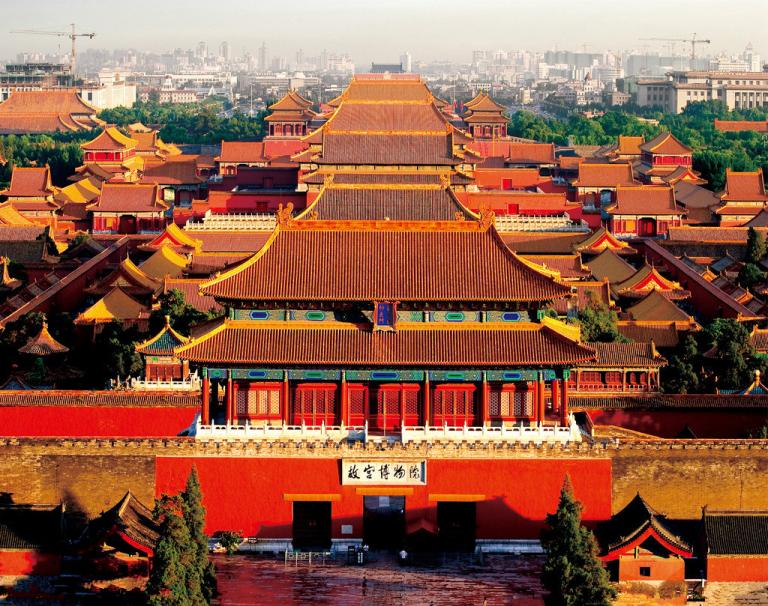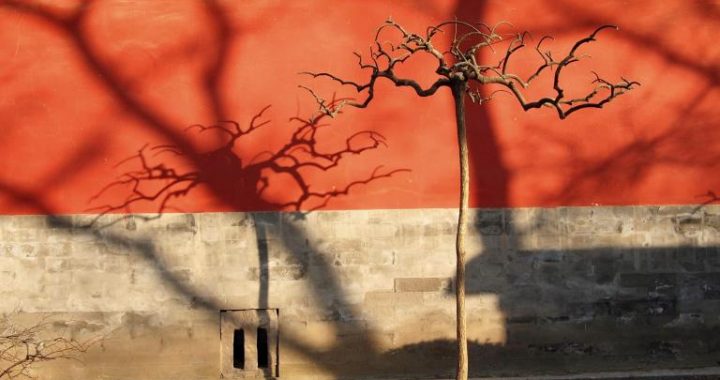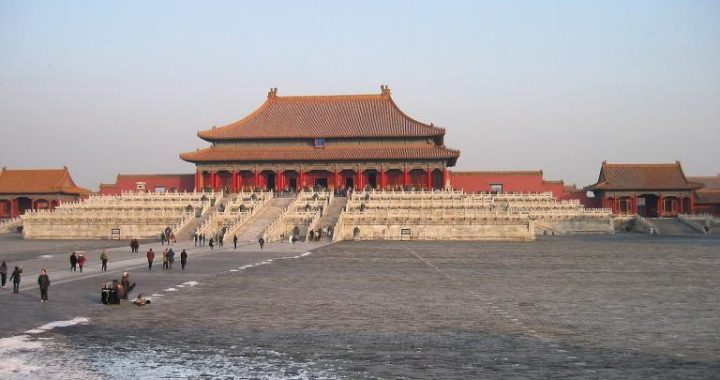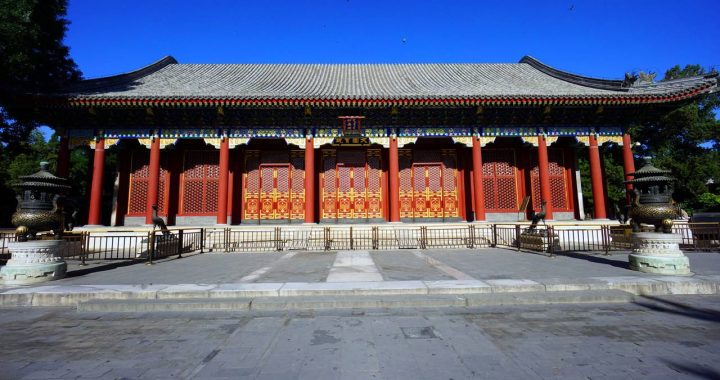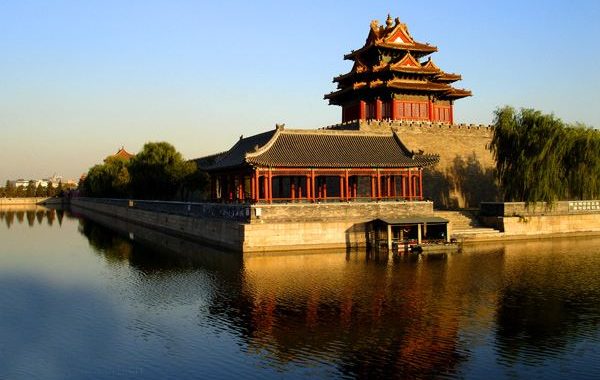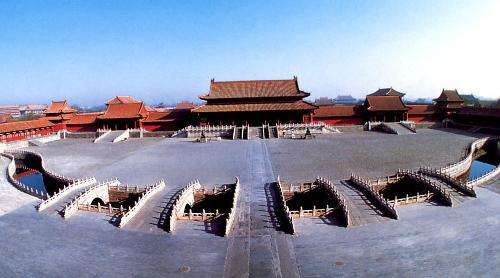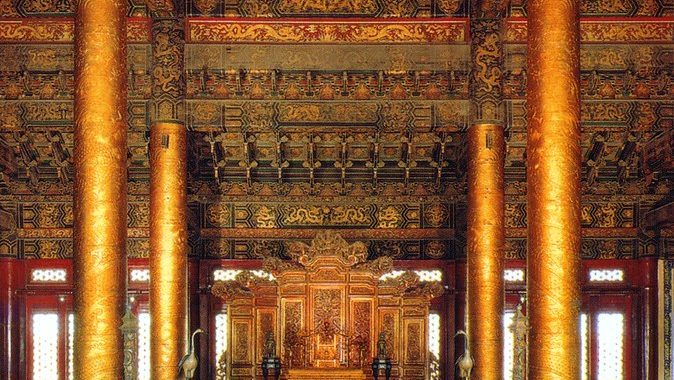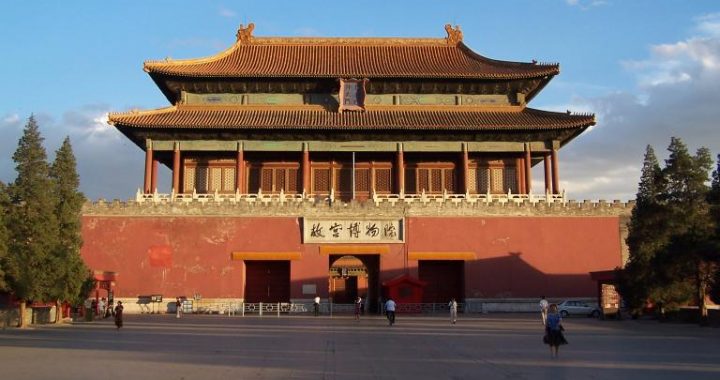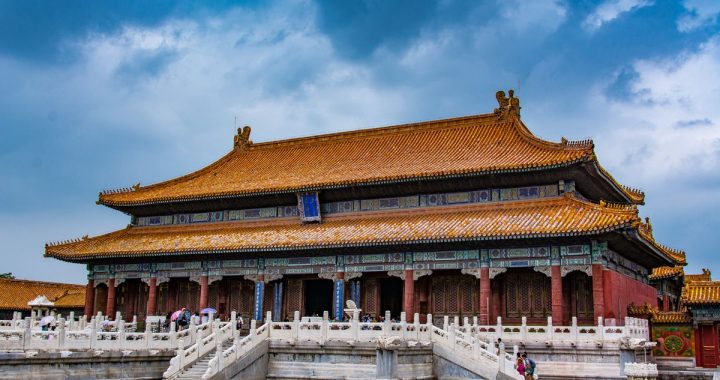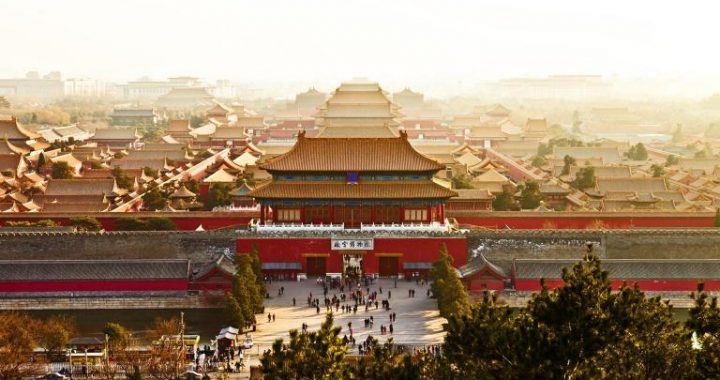Beijing Forbidden City
12 min readSay some friends come to Beijing and have only one day to be introduced to traditional Chinese culture. They might choose to attend an exhibition of Chinese ink painting, enjoy a performance of Beijing opera, or go to a concert of traditional Chinese music. But none of these activities would leave as deep an impression as a visit to Beijing’s Imperial Palace. The Imperial Palace is located in the ancient Forbidden City at the heart of Beijing. Constructed during the Ming and Qing Dynasties, it is the only intact imperial Chinese palace in existence.
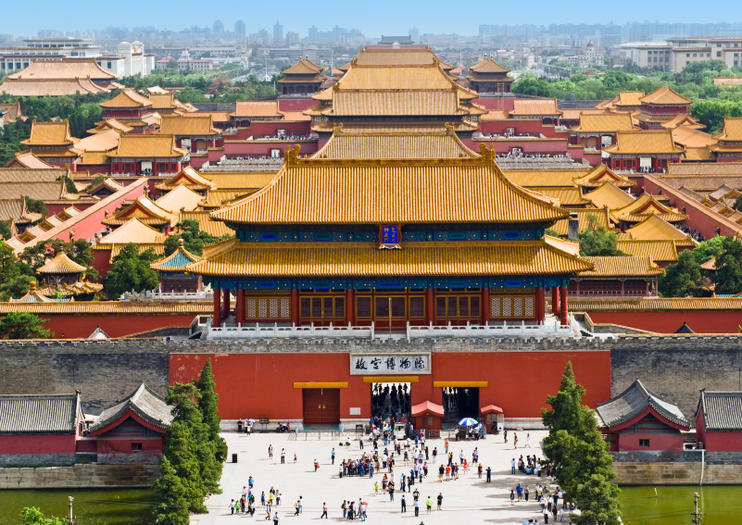
The main entrance to the Forbidden City, located at the center of the complex’s south perimeter, is called Wumen Gate (the Meridian Gate). Leading up to the entrance are three interconnected plazas, the outermost of which is Tian’anmen Square. The original Tian’anmen Square was T-shaped, and much smaller than today’s version. It was entered through the small and simple gate Damingmen Gate, which no longer exists, with low and unadorned corridors leading into the square on either side. The entrance and corridors were intentionally simple, in order to emphasize the grand scale and magnificence of Tian’anmen Square. The second plaza, Duanmen Square, was square in shape. It served as a transitional space leading into the grandest of the three plazas, Wumen Square. At the far end of Wumen Square stands the huge and ornate Wumen Gate, the focal point of the three interconnected plazas. The massive “arms” of the U-shaped gate stretch out to either side, creating an atmosphere of awesome power and grandeur.
Inside Wumen Gate, the palace complex consists of three sections laid out along a central north-south axis. The first section, or outer court, is where the Emperor conducted affairs of state. It contains three halls, of which the Hall of Supreme Harmony is the most important. The atmosphere of this magnificent structure is dignified and imposing, embodying the inviolable authority of the Emperor. The middle section, or inner court, is where the Emperor and his household resided. The layout of the three halls of the inner court reflects that of the outer court, but on a smaller scale, and the atmosphere is more tranquil. The final section of the palace complex, known as the Imperial Garden, is the smallest. It is full of life, lush with greenery and the scent of flowers floating on the air. Behind the Forbidden City is Jingshan Mountain, which was constructed by human labor. Five pavilions are located along the crest of the mountain. Jingshan Mountain serves as the scenic backdrop for the Forbidden City, and a fitting end point for the entire palace complex.
The Ancestral Temple and the Altar to the Deity of Land and Grain, are located on either side of Wumen Gate.
Imperial palaces were often decorated with highly detailed and formal Hexi color paintings.
The Forbidden City can be compared to a symphony in three parts. The three plazas leading up to the palace complex are the prelude, the halls of the palace complex are the climax, and Jingshan Mountain is the coda. The Forbidden City is characterized by its organic layout, imposing architectural forms, and distinctive use of color, as well as the precise orientation of its courtyards and the gorgeous ornamentation of its buildings. Every element worked together to proclaim the power and magnificence of the Emperor and to create a sense of awe.
These sections can also be compared to the three movements of a symphony. The southernmost section was the prelude. It stretched from Yongdingmen, the southern gate of the outer city wall, north to Zhengyangmen, the southern gate of the inner city wall. This section was the largest and most freely laid out. The middle section was the climax of the symphony. It encompassed the Forbidden City, as well as the plazas in front of it and Jingshan Mountain behind it. This section was relatively small and was the most stringently laid out. The northernmost and smallest section Old Beijing was laid out on an north-south axis in three sections. These sections can also be compared to the three movements of a symphony. The southernmost section was the prelude. It stretched from Yongdingmen, the southern gate of the outer city wall, north to Zhengyangmen, the southern gate of the inner city wall. This section was the largest and most freely laid out. The middle section was the climax of the symphony. It encompassed the Forbidden City, as well as the plazas in front of it and Jingshan Mountain behind it. This section was relatively small and was the most stringently laid out. The northernmost and smallest section was the coda, reaching from Jingshan Mountain in the south to the Bell and Drum Towers in the north, the rousing final chord of the symphony. Beyond the Bell and Drum Towers’ northern gates, old Beijing fades out to the horizon, like the symphony’s final distant echoes. Providing harmonic accompaniment to the theme of Old Beijing are its city walls and gate towers, streets and ceremonial altars. The layout and architecture of the entire old city are as organically integrated as a piece of music, and as harmonious and stirring as an epic poem.
In his famous work Science and Civilization in China, renowned British scholar Dr. Joseph Needham (1900-1995 AD) had this to say about the design of the Forbidden City: “…the Chinese concept [of architecture] is very profound and complicated. The palace complex consists of hundreds of structures which are an integrated part of the greater city whole, including the city walls and streets.” Needham believed that China’s holistic architecture stand above that of any otherulture. The holistic nature of Chinese architecture is not just a matter of form and technique. It also has deep cultural significance.
Confucianism, one of the dominant trends of Chinese culture, holds that people are society’s most important element. Confucianism attached particular importance to achieving a unified and harmonious society in which imperial authority was paramount and long-term political stability was emphasized. Confucianism utilized an elaborate system of rites to control all aspects of life and to strengthen the centralized authority of the Emperor. In the area of architecture, palace design and urban planning were highly effective means of reinforcing imperial power.
The most important technique for establishing this type of rigidly controlled society was laid out in the Confucian classic Yue Ji (The Book of music), which directs, “Unify the people with music; differentiaterank according to the Rites. “Differentiate “meant to distinguish social status according to the hierar chical rankings of China’s feudal society in order to establish a system of government controlled bythe ruling class. “Unify “meant to establish a sense of common purpose among the people, in order to persuade them to accept the unquestionable legitimacy of imperial authority. according to confucian ism, this was the way to create a harmonious and stable society. China s cities and palaces embodied this psychology, strictly differentiating status and class, while at the same time blending them into a harmonious whole .
Traditional Chinese culture also emphasizes the harmonious coexistence of humanity and nature.This tradition was also reflected in urban architecture. For instance, Beijing’s four major ceremonial altars were located equidistant around the periphery of the city, with the Forbidden City in the center Every year on the solstices and equinoxes, the emperor would make sacrifices at the appropriate altars in accordance with the holistic concept of the Unity of Humanity and Nature. according to traditional correspondences of the planets,seasons,and directions,the rites were carried out at the Temple ofHeaven in the south in the summer,the Temple of Earth in the north in the winter,the Temple of the Sun in the east in the spring,and the Temple of the Moon in the west in the fall Diagram of a central structure from Banpo Neolithic Village,Xi’an Palace architecture developed over a long period Its origins may be traced back to the large structures found at the center of matriarchal Neolithic settlements These structures were where triballeaders lived,held gatherings,and conducted sacrifices.The shape of these large central structures,including their doors,windows and roof,is reflected in the ancient pictographic jiaguwen(oracle bone)character for palace(gong).
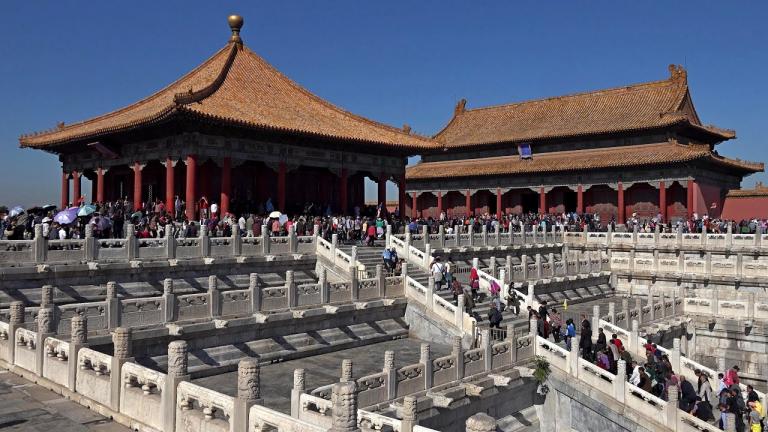
The palaces of the Xia Dynasty(.2070-1600 BC)were self-contained compounds.The palace compound discovered at the Erlitou site in Yanshi,Henan Province dates back to the late Xia Dynasty Inside the compound is a large palace structure divided into separate rooms.It combined three func tions,serving as an integrated residence,center of government,and site of ceremonial activities A more recent palace complex discovered at Qishan,Shaanxi Province dates back to the late Shang or early Zhou Dynasty(c 9-11th century BC).It consists of two interconnected compounds.The outer compound contained a plaza and a hall that was used for meetings and ceremonial activities,while theinner compound served as a residence.This indicates that by this time,various social functions were being conducted separately .
Palaces and ceremonial structures were clearly differentiated by the time of the Western Zhou Dynasty (1046-771 BC). However, they were still closely related and formed integral components of urban ar chitecture. China’s holistic concept of urban planning is clearly laid out in The Artisan’s Record(c. late Spring and Autumn Period, 770-476 BC), China’s oldest known collection of codes and regulations for the architectural arts and other crafts. The section”Building a Capital city “concerns the construction of Luoyi, the auxiliary capital of the Western Zhou Dynasty which later became the capital of the East- ern Zhou Dynasty. It states: “In designing a capital city, the architect should lay it out as a square nine li labout 4.5 kilometers] to a side, oriented to the cardinal directions, with three gates on each side. There hould be nine streets running north-south and nine avenues running east-west, each wide enough for nine carts to easily travel abreast. The palace complex should be in the center, with the Ancestral Hall to the east and the altar to the deity of Land and grain to the west a plaza and administrative buildings in front and a market place behind. It can be seen that the ideal capital city was meant to be square in shape and laid out symmetrically on a north-south axis. The palace was in the central position with ritual structures located on either side, indicating that by this time, imperial authority had surpassed clan and religious authority.
The palace complex itself consisted of a number of gates located along the central north-south axis linking courts that contained plazas and halls. Including the city gate and the gates of the ancestral Hall and altar of Land and grain, the ideal palace complex consisted of “five gates and three courtsThe outer court was the site of the most important ceremonial activities. The middle court was where the emperor met with important dignitaries to discuss affairs of state. The inner court was where daily official business was carried out. In order to increase the grandeur of the outer court, it was backed by a massive gate, analogous to the Forbidden City’s Wumen Gate, as well as two flat-topped towers on either side of the gate. Behind the “five gates and three courts”were a series of small courtyards where the Emperor and the imperial household resided .
By the time of the Spring and Autumn and Warring States Periods, Confucianism had adopted the system of rites dating from the Zhou Dynasty into a comprehensive system of social control. architec ture was an important component of this system, utilized as an effective tool for reinforcing imperial authority. The design concepts enshrined in the Rites have been passed down for thousands of years, and are exemplified in Beijing’ s Forbidden City .
Confucian architecture differentiated status by positioning buildings symmetrically along either side of a central axis. In accordance with the concept that the center is paramount the principal palace was located at the most auspicious and important point, close to the midpoint of the central axis. The layout of luoyi, the capital city of the eastern Zhou dynasty is in strict accordance with Confucian concepts, and was therefore used as a model of Confucian architecture Confucianism promoted a moderate artistic style that emphasized the Doctrine of the Mean, or balanc ing extremes to achieve harmony. The Confucian pursuit of harmony had a major influence on Chinese rt, including architecture. It also contributed to the development of the more harmonious and introspective aspects of the psychology of the Chinese people Confucianism places great importance on the eternal nature of the spirit. This has led the Chinese things. As a result, China developed the only world architectural tradition based on wood, a livingpeople to develop a pragmatic outlook that does not emphasize the pursuit of permanence in material material, rather than stone. The use of wood is also related to Confucian precepts of benevolent rule and respect for agricultural production. Wood is both readily available and easily worked Stone, on the other hand, must be laboriously quarried and finished, which would cause undue hardship to the peo ple as well as divert labor from the fields. Wood construction also conforms with the confucian sense of aesthetics, which advocates harmony with the environment and a gentle sensibility. China’s woodframe architecture contrasts strongly with Western and islamic architectural traditions which seek to create enduring, imposing constructions. Western architecture in particular has traditionally usedstone construction in the pursuit of grandeur. Great cathedrals required decades or even centuries of intensive labor to complete.
Due to the restrictions of wood frame construction individual chinese buildings were limited in size and structural complexity.As a result,changing rooflines most clearly reflect the evolution of chinese architecture.Also,a number of methods were developed to increase the impression of grandeur in palace architecture.Palace complexes consisted of courtyards and structures laid out longitudinally along a central north-south axis.The contrast between the size and style of the individual structures the various ways in which courtyards were linked together,the space and design of each courtyard and the transitions between interior and exterior spaces all contributed to a sense of great splendor and orderliness.Integrated groupings are central to Chinese architectural design,and individual elements are often adapted according to the requirements of the overall design.
Chinese architecture resembles a painting.Each structure of a grouping is like a brushstroke of varying length,thickness,and shade Just as an individual brushstroke loses its significance outside of its painting,individual structures must be taken in the context of their architectural grouping The city walls and courtyard walls that enclose architectural groupings are like the frame of a painting The gate towers and watchtowers ofthe city walls and the gates of courtyard walls are key decorative elements of the frame.The frame serves to contain and restrain the interior architectural elements In China,architecture looks inward enclosing the group of people it shelters.By promoting an intrinsically communal environment,Chi nese architectural design has exerted a deep and subtle influence on the chinese national character Chang’an,the capital city of the Sui(581-618 AD)and Tang Dynasties(618-907 AD),was the largest city in classical China.Its city walls were composed of three sections-the outer city wall,the wall around the imperial city,and the wall around the inner palace city.The city streets were laid out on a symmetrical grid,with the vertical,north-south axis approximately nine kilometers long.
The impe rial city and palace complex were located in the center of the city,bordered on the south by an east west avenue lined with markets.The imperial city was the site of the central governmental offices with the Ancestral Temple and the altar to the Deity of Land and grain located at its southeast and southwest corners respectively.In the center of the imperial city was the palace complex.It was com prised of three main sections,laid out horizontally.Taiji Palace,the principal and largest palace for state affairs,occupied the central place of honor The East Palace was occupied by the imperial princes while the West Palace was the residence of the empress and imperial concubines During the Tang Dynasty,an additional construction,the magnificent Daming Palace complex,was built in the northeastern section of Chang’an.It maintained the grandeur of previous dynasties,while incorporating the great architectural advances of the time.The main hall,Hanyuan Palace,was linked by corridors to two pavilions located on artificial hills to the east and west.The resulting U-shape was the precursor for the U-shaped Wumen Gate of the Forbidden City in Beijing.
This magnificent archi tecture reflects the self-confident and optimistic spirit of the great Tang period of peace and prosperity Although the Yuan Dynasty(1271-1368 AD)was ruled by Mongolian Emperors,the capital city of Dadu(present-day Beijing)brilliantly embodied the aesthetics and architectural concepts of Confucianism Dadu was centered around Qionghuadao Lake(present-day Beihai and Zhonghai Lakes),with the palace complex constructed along the eastern bank.The city of Dadu was essentially square n shape,with nine major east-west avenues and nine major north-south streets.The Drum Tower district to the north of the imperial city was the principal market area.To the west was the altar to the Deity of Land and Grain,and to the east was the Ancestral Temple.Dadu was the direct predecessor of Beijing, the capital of the ming and Qing Dynasties Arial view of Dadu during the Yuan Dynasty.
